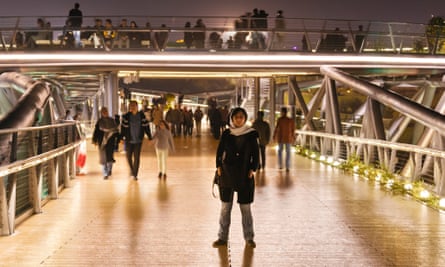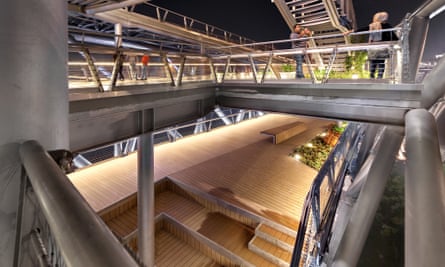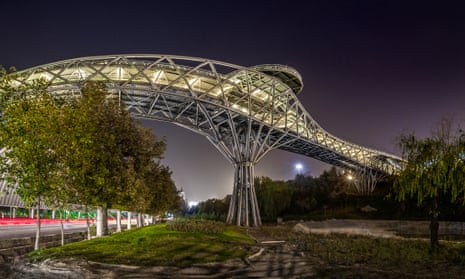Bridges have always been close to the heart of Iranian identity. Isfahan, Iran’s top tourist destination and a former capital of Persia, boasts two spectacular bridges from the 16th century Safavid dynasty when the city was at the centre of Islamic art and culture.
So it is no surprise that a new hi-tech award-winning structure has appeared in the Iranian capital, Tehran. What is a surprise is that it was designed by a young woman.Tabiat (“nature”) bridge, the largest of its kind in Iran, was architect Leila Araghian’s first project. She designed it five years ago while a student, winning a local competition for a plan to connect two parks separated by a highway in north Tehran.

It was built over two years and was unveiled in late 2014 by Tehran’s mayor, Mohammad Bagher Ghalibaf. It has since become a popular place for hangouts and morning sports. Last month, as Iranians celebrated an ancient festival of outdoor picnicking, thousands flocked to the bridge.
“I didn’t want it to be just a bridge which people would use to get from one park to another,” said Araghian, who is now 31. “I wanted it to be a place for people to stay and ponder, not simply pass.”
Built on three large pillars, the 270-metre curved structure has broad entrances, multiple pathways and three floors of restaurants and cafes and sitting areas. It was recently named among the winners of the Architizer A+ awards, a global architectural competition based in New York.
Tabiat is reminiscent of Isfahan’s Siosepol, whose name means bridge of 33 arches, and Khaju bridge, which are a place for public meetings, poetry reading and traditional tea houses.
Araghian said she initially lacked confidence and wasn’t sure people would welcome her modern design. But now, as she sets foot on the structure that was once just an idea in her head, she can see the scale of her achievement.
“I used to say it’s just a piece of design on the paper, I couldn’t believe it would actually be built one day,” she told the Guardian. “It’s a good feeling to see people are enjoying it, to see them sitting on the benches or just hanging out. It gives me more confidence for my future work but when I come to think of it, it’s one of those things that you get to do only once in your lifetime.”
Araghian studied architecture at Tehran’s Shahid Beheshti University and together with a colleague, Alireza Behzadi, founded Diba Tensile Architecture. The Italy-based Maffeis Engineering helped with the technical side of the Tabiat project.
It hasn’t all been easy. At one point, an Australian company delayed providing Araghian and her colleagues with computer software they needed because the project originated in Iran, which is under international sanctions because of its nuclear programme.

Sanctions continue to trouble Araghian even now. Most recently, she was not allowed to enter a top UK architecture competition because she was from Iran.
“The UK government has committed itself to a sanctions programme in respect of Iran, which we hope will soon be eased,” Paul Finch, programme director at World Architecture Festival, wrote to Araghian, explaining why she could not enter.
“These sanctions in turn have resulted in our owner-company, the Top Right Group, becoming subject to the provisions of that programme. And in turn it means that WAF, along with all our other events and publications, cannot undertake business activity with Iran currently.”

Araghian said she was deeply disappointed by such sanctions targeting ordinary people like her. “This is ridiculous, I’m an Iranian architect and this is a cultural activity, it has absolutely nothing to do with politics,” she said. “This is very discriminatory.”
At home, Araghian is happy the city authorities trusted her although she was young and without much experience. “That’s very valuable to me,” she said.
Under Ghalibaf, Tehran has built a significant number of new bridges, tunnels and parks. Speaking during Tabiat’s inauguration ceremony, the mayor express delight that its designers were from the younger generation. “This is the longest pedestrian bridge in our country and has been designed beautifully by our youth,” he said.
Kamran Rezaianpour, a professor and director of the Idehandish architecture company, said Tehran’s municipal budget had significantly increased under Ghalibaf.
“He pays a great attention to monumental projects which last long, something like France where presidents tend to leave such structures behind,” Rezaianpour said. Commenting on the design of Tabiat bridge, he added: “Such projects will break the taboo of working on complex designs in Iran and will pave ways for more avant garde Iranian architects.”

Comments (…)
Sign in or create your Guardian account to join the discussion